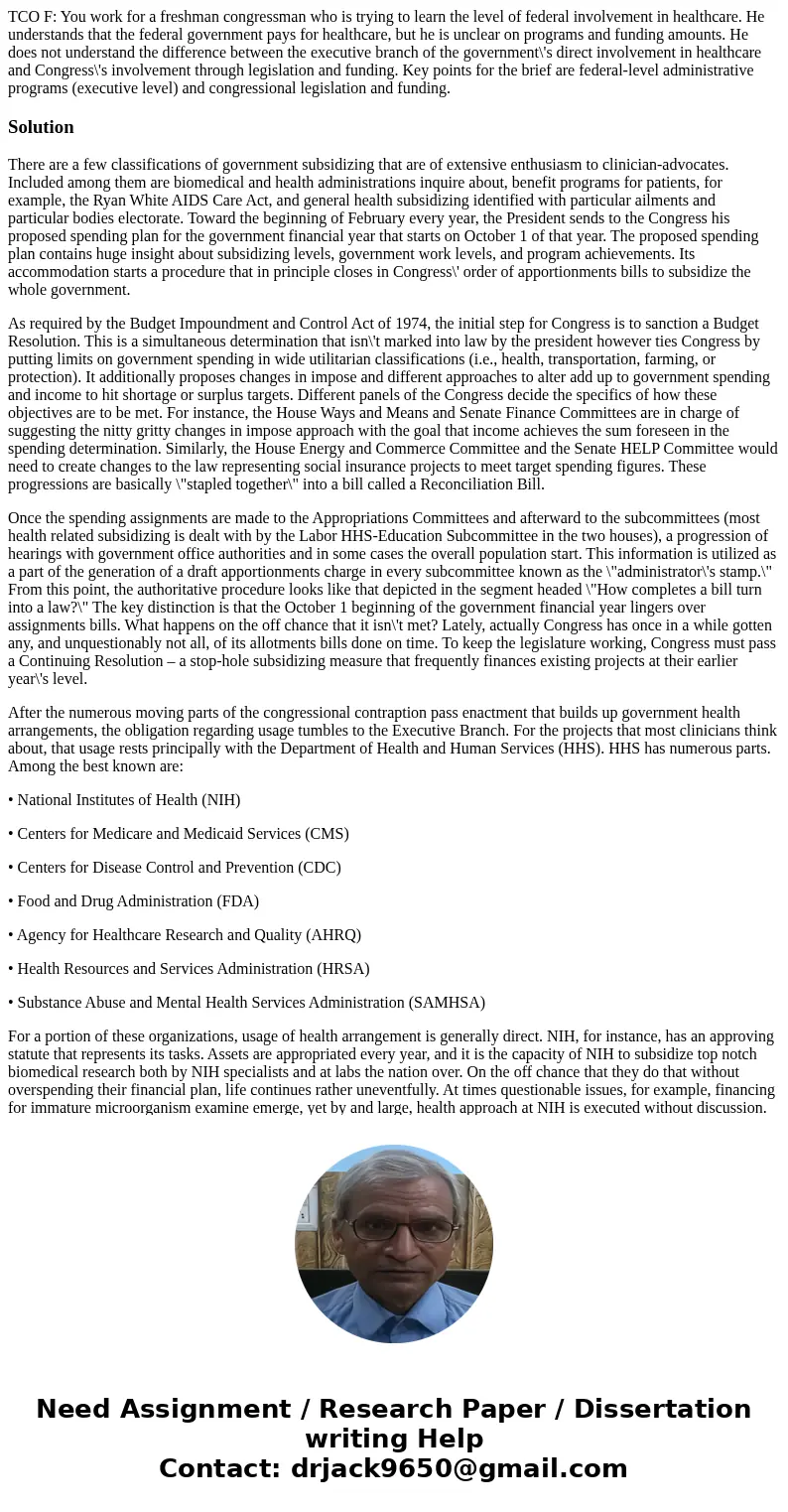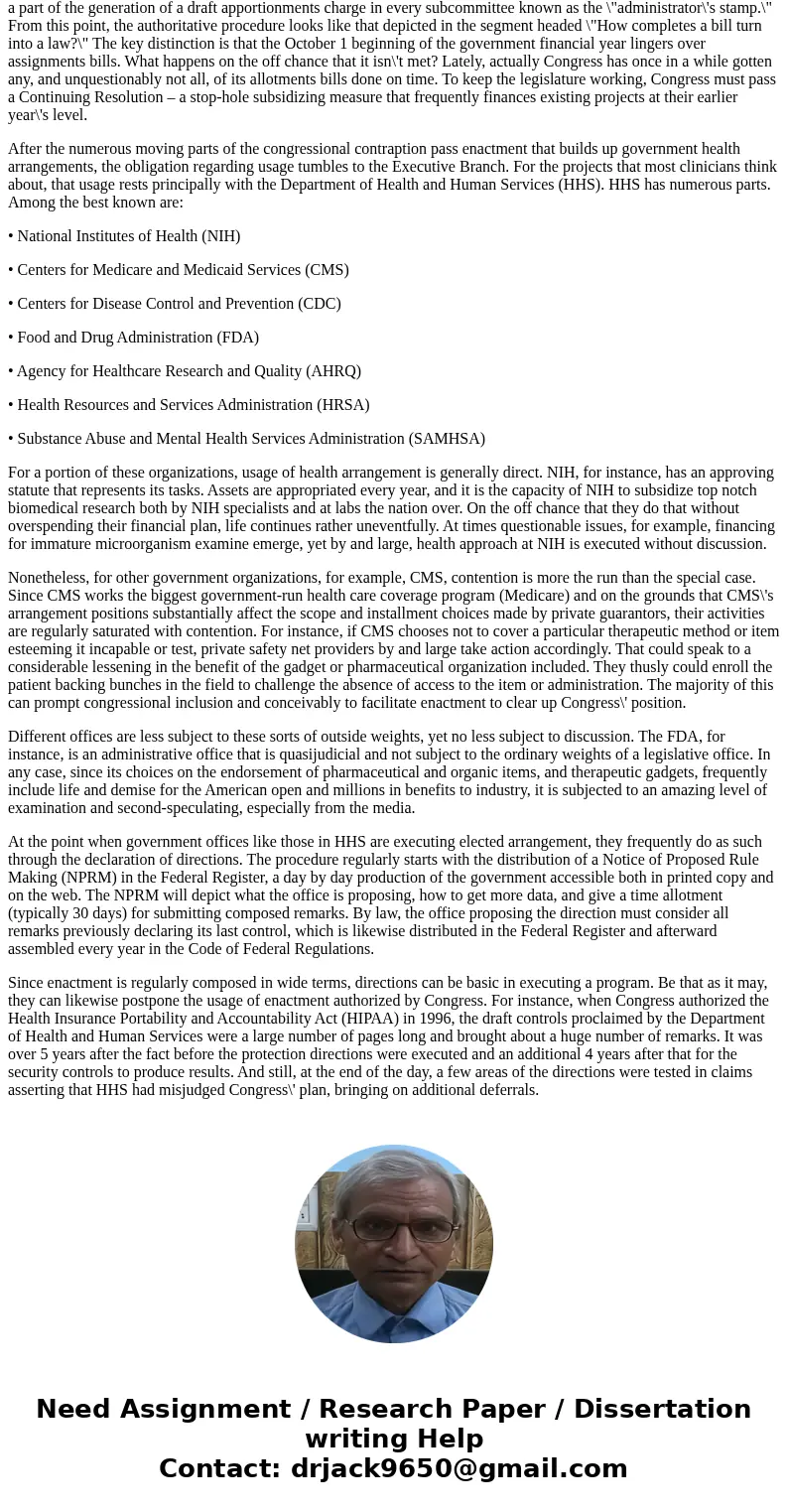TCO F You work for a freshman congressman who is trying to l
TCO F: You work for a freshman congressman who is trying to learn the level of federal involvement in healthcare. He understands that the federal government pays for healthcare, but he is unclear on programs and funding amounts. He does not understand the difference between the executive branch of the government\'s direct involvement in healthcare and Congress\'s involvement through legislation and funding. Key points for the brief are federal-level administrative programs (executive level) and congressional legislation and funding.
Solution
There are a few classifications of government subsidizing that are of extensive enthusiasm to clinician-advocates. Included among them are biomedical and health administrations inquire about, benefit programs for patients, for example, the Ryan White AIDS Care Act, and general health subsidizing identified with particular ailments and particular bodies electorate. Toward the beginning of February every year, the President sends to the Congress his proposed spending plan for the government financial year that starts on October 1 of that year. The proposed spending plan contains huge insight about subsidizing levels, government work levels, and program achievements. Its accommodation starts a procedure that in principle closes in Congress\' order of apportionments bills to subsidize the whole government.
As required by the Budget Impoundment and Control Act of 1974, the initial step for Congress is to sanction a Budget Resolution. This is a simultaneous determination that isn\'t marked into law by the president however ties Congress by putting limits on government spending in wide utilitarian classifications (i.e., health, transportation, farming, or protection). It additionally proposes changes in impose and different approaches to alter add up to government spending and income to hit shortage or surplus targets. Different panels of the Congress decide the specifics of how these objectives are to be met. For instance, the House Ways and Means and Senate Finance Committees are in charge of suggesting the nitty gritty changes in impose approach with the goal that income achieves the sum foreseen in the spending determination. Similarly, the House Energy and Commerce Committee and the Senate HELP Committee would need to create changes to the law representing social insurance projects to meet target spending figures. These progressions are basically \"stapled together\" into a bill called a Reconciliation Bill.
Once the spending assignments are made to the Appropriations Committees and afterward to the subcommittees (most health related subsidizing is dealt with by the Labor HHS-Education Subcommittee in the two houses), a progression of hearings with government office authorities and in some cases the overall population start. This information is utilized as a part of the generation of a draft apportionments charge in every subcommittee known as the \"administrator\'s stamp.\" From this point, the authoritative procedure looks like that depicted in the segment headed \"How completes a bill turn into a law?\" The key distinction is that the October 1 beginning of the government financial year lingers over assignments bills. What happens on the off chance that it isn\'t met? Lately, actually Congress has once in a while gotten any, and unquestionably not all, of its allotments bills done on time. To keep the legislature working, Congress must pass a Continuing Resolution – a stop-hole subsidizing measure that frequently finances existing projects at their earlier year\'s level.
After the numerous moving parts of the congressional contraption pass enactment that builds up government health arrangements, the obligation regarding usage tumbles to the Executive Branch. For the projects that most clinicians think about, that usage rests principally with the Department of Health and Human Services (HHS). HHS has numerous parts. Among the best known are:
• National Institutes of Health (NIH)
• Centers for Medicare and Medicaid Services (CMS)
• Centers for Disease Control and Prevention (CDC)
• Food and Drug Administration (FDA)
• Agency for Healthcare Research and Quality (AHRQ)
• Health Resources and Services Administration (HRSA)
• Substance Abuse and Mental Health Services Administration (SAMHSA)
For a portion of these organizations, usage of health arrangement is generally direct. NIH, for instance, has an approving statute that represents its tasks. Assets are appropriated every year, and it is the capacity of NIH to subsidize top notch biomedical research both by NIH specialists and at labs the nation over. On the off chance that they do that without overspending their financial plan, life continues rather uneventfully. At times questionable issues, for example, financing for immature microorganism examine emerge, yet by and large, health approach at NIH is executed without discussion.
Nonetheless, for other government organizations, for example, CMS, contention is more the run than the special case. Since CMS works the biggest government-run health care coverage program (Medicare) and on the grounds that CMS\'s arrangement positions substantially affect the scope and installment choices made by private guarantors, their activities are regularly saturated with contention. For instance, if CMS chooses not to cover a particular therapeutic method or item esteeming it incapable or test, private safety net providers by and large take action accordingly. That could speak to a considerable lessening in the benefit of the gadget or pharmaceutical organization included. They thusly could enroll the patient backing bunches in the field to challenge the absence of access to the item or administration. The majority of this can prompt congressional inclusion and conceivably to facilitate enactment to clear up Congress\' position.
Different offices are less subject to these sorts of outside weights, yet no less subject to discussion. The FDA, for instance, is an administrative office that is quasijudicial and not subject to the ordinary weights of a legislative office. In any case, since its choices on the endorsement of pharmaceutical and organic items, and therapeutic gadgets, frequently include life and demise for the American open and millions in benefits to industry, it is subjected to an amazing level of examination and second-speculating, especially from the media.
At the point when government offices like those in HHS are executing elected arrangement, they frequently do as such through the declaration of directions. The procedure regularly starts with the distribution of a Notice of Proposed Rule Making (NPRM) in the Federal Register, a day by day production of the government accessible both in printed copy and on the web. The NPRM will depict what the office is proposing, how to get more data, and give a time allotment (typically 30 days) for submitting composed remarks. By law, the office proposing the direction must consider all remarks previously declaring its last control, which is likewise distributed in the Federal Register and afterward assembled every year in the Code of Federal Regulations.
Since enactment is regularly composed in wide terms, directions can be basic in executing a program. Be that as it may, they can likewise postpone the usage of enactment authorized by Congress. For instance, when Congress authorized the Health Insurance Portability and Accountability Act (HIPAA) in 1996, the draft controls proclaimed by the Department of Health and Human Services were a large number of pages long and brought about a huge number of remarks. It was over 5 years after the fact before the protection directions were executed and an additional 4 years after that for the security controls to produce results. And still, at the end of the day, a few areas of the directions were tested in claims asserting that HHS had misjudged Congress\' plan, bringing on additional deferrals.


 Homework Sourse
Homework Sourse